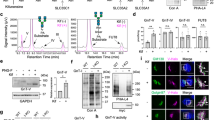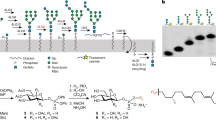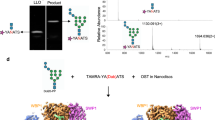Abstract
The endoplasmic reticulum (ER) is the site of folding for proteins that are resident in the ER or that are destined for the Golgi, endosomes, lysosomes, the plasma membrane, or secretion. Cotranslational addition of preassembled glucose3-mannose9-N-acetylglucosamine2 core oligosaccharides (N-glycosylation) is a common event for polypeptides synthesized in this compartment. Protein-bound oligosaccharides are exposed to several ER glycanases that sequentially remove terminal glucose or mannose residues. Their activity must be tightly regulated because the N-glycan composition determines whether the associated protein is subjected to folding attempts in the ER lumen or whether it is retrotranslocated into the cytosol and degraded.
This is a preview of subscription content, access via your institution
Access options
Subscribe to this journal
Receive 12 print issues and online access
$259.00 per year
only $21.58 per issue
Buy this article
- Purchase on Springer Link
- Instant access to full article PDF
Prices may be subject to local taxes which are calculated during checkout




Similar content being viewed by others
References
Ellgaard, L., Molinari, M. & Helenius, A. Setting the standards: quality control in the secretory pathway. Science 286, 1882–1888 (1999).
Meusser, B., Hirsch, C., Jarosch, E. & Sommer, T. ERAD: the long road to destruction. Nat. Cell Biol. 7, 766–772 (2005).
Romisch, K. Endoplasmic reticulum-associated degradation. Annu. Rev. Cell Dev. Biol. 21, 435–456 (2005).
McCracken, A.A. & Brodsky, J.L. Evolving questions and paradigm shifts in endoplasmic-reticulum-associated degradation (ERAD). Bioessays 25, 868–877 (2003).
Helenius, A. & Aebi, M. Roles of N-linked glycans in the endoplasmic reticulum. Annu. Rev. Biochem. 73, 1019–1049 (2004).
Hebert, D.N., Garman, S.C. & Molinari, M. The glycan code of the endoplasmic reticulum: asparagine-linked carbohydrates as protein maturation and quality-control tags. Trends Cell Biol. 15, 364–370 (2005).
Molinari, M. & Helenius, A. Chaperone selection during glycoprotein translocation into the endoplasmic reticulum. Science 288, 331–333 (2000).
Soldà, T., Garbi, N., Hammerling, G.J. & Molinari, M. Consequences of ERp57 deletion on oxidative folding of obligate and facultative clients of the calnexin cycle. J. Biol. Chem. 281, 6219–6226 (2006).
Zapun, A. et al. Enhanced catalysis of ribonuclease B folding by the interaction of calnexin or calreticulin with ERp57. J. Biol. Chem. 273, 6009–6012 (1998).
Oliver, J.D., van der Wal, F.J., Bulleid, N.J. & High, S. Interaction of the thiol-dependent reductase ERp57 with nascent glycoproteins. Science 275, 86–88 (1997).
Molinari, M. & Helenius, A. Glycoproteins form mixed disulphides with oxidoreductases during folding in living cells. Nature 402, 90–93 (1999).
Jessop, C.E. et al. ERp57 is essential for efficient folding of glycoproteins sharing common structural domains. EMBO J. 26, 28–40 (2007).
Maattanen, P., Kozlov, G., Gehring, K. & Thomas, D.Y. ERp57 and PDI: multifunctional protein disulfide isomerases with similar domain architectures but differing substrate–partner associations. Biochem. Cell Biol. 84, 881–889 (2006).
Gurkan, C., Stagg, S.M., Lapointe, P. & Balch, W.E. The COPII cage: unifying principles of vesicle coat assembly. Nat. Rev. Mol. Cell Biol. 7, 727–738 (2006).
Molinari, M., Galli, C., Vanoni, O., Arnold, S.M. & Kaufman, R.J. Persistent glycoprotein misfolding activates the glucosidase II/UGT1-driven calnexin cycle to delay aggregation and loss of folding competence. Mol. Cell 20, 503–512 (2005).
Kopito, R.R. Biosynthesis and degradation of CFTR. Physiol. Rev. 79, S167–S173 (1999).
Kopito, R.R. & Ron, D. Conformational disease. Nat. Cell Biol. 2, E207–E209 (2000).
Molinari, M. & Sitia, R. The secretory capacity of a cell depends on the efficiency of endoplasmic reticulum-associated degradation. Curr. Top. Microbiol. Immunol. 300, 1–15 (2005).
Eriksson, K.K. et al. EDEM contributes to maintenance of protein folding efficiency and secretory capacity. J. Biol. Chem. 279, 44600–44605 (2004).
Ruddock, L.W. & Molinari, M. N-glycan processing in ER quality control. J. Cell Sci. 119, 4373–4380 (2006).
Yoshida, Y., Murakami, A., Iwai, K. & Tanaka, K. A neural-specific F-box protein FBS1 functions as a chaperone suppressing glycoprotein aggregation. J. Biol. Chem. 282, 7137–7144 (2007).
Yoshida, Y. et al. E3 ubiquitin ligase that recognizes sugar chains. Nature 418, 438–442 (2002).
Hirsch, C., Blom, D. & Ploegh, H.L. A role for N-glycanase in the cytosolic turnover of glycoproteins. EMBO J. 22, 1036–1046 (2003).
Caramelo, J.J., Castro, O.A., de Prat-Gay, G. & Parodi, A.J. The endoplasmic reticulum glucosyltransferase recognizes nearly native glycoprotein folding intermediates. J. Biol. Chem. 279, 46280–46285 (2004).
Ritter, C., Quirin, K., Kowarik, M. & Helenius, A. Minor folding defects trigger local modification of glycoproteins by the ER folding sensor GT. EMBO J. 24, 1730–1738 (2005).
Molinari, M., Galli, C., Piccaluga, V., Pieren, M. & Paganetti, P. Sequential assistance of molecular chaperones and transient formation of covalent complexes during protein degradation from the ER. J. Cell Biol. 158, 247–257 (2002).
Cabral, C.M., Liu, Y., Moremen, K.W. & Sifers, R.N. Organizational diversity among distinct glycoprotein endoplasmic reticulum-associated degradation programs. Mol. Biol. Cell 13, 2639–2650 (2002).
Svedine, S., Wang, T., Halaban, R. & Hebert, D.N. Carbohydrates act as sorting determinants in ER-associated degradation of tyrosinase. J. Cell Sci. 117, 2937–2949 (2004).
Hendershot, L.M. The ER function BiP is a master regulator of ER function. Mt. Sinai J. Med. 71, 289–297 (2004).
Taylor, S.C., Ferguson, A.D., Bergeron, J.J. & Thomas, D.Y. The ER protein folding sensor UDP-glucose glycoprotein-glucosyltransferase modifies substrates distant to local changes in glycoprotein conformation. Nat. Struct. Mol. Biol. 11, 128–134 (2004).
Moremen, K.W. in Alpha-Mannosidases in Asparagine-Linked Oligosaccharide Processing and Catabolism Vol. 2 (eds. Ernst, B., Hart, G. & Sinay, P.) 81–117 (John Wiley and Sons, Inc., New York, 2000).
Lederkremer, G.Z. & Glickman, M.H. A window of opportunity: timing protein degradation by trimming of sugars and ubiquitins. Trends Biochem. Sci. 30, 297–303 (2005).
Sousa, M.C., Ferrero-Garcia, M.A. & Parodi, A.J. Recognition of the oligosaccharide and protein moieties of glycoproteins by the UDP-Glc:glycoprotein glucosyltransferase. Biochemistry 31, 97–105 (1992).
Spiro, R.G., Zhu, Q., Bhoyroo, V. & Soling, H.D. Definition of the lectin-like properties of the molecular chaperone, calreticulin, and demonstration of its copurification with endomannosidase from rat liver Golgi. J. Biol. Chem. 271, 11588–11594 (1996).
Cabral, C.M., Liu, Y. & Sifers, R.N. Dissecting glycoprotein quality control in the secretory pathway. Trends Biochem. Sci. 26, 619–624 (2001).
Moremen, K.W. & Molinari, M. N-linked glycan recognition and processing: the molecular basis of endoplasmic reticulum quality control. Curr. Opin. Struct. Biol. 16, 592–599 (2006).
Jakob, C.A., Burda, P., Roth, J. & Aebi, M. Degradation of misfolded endoplasmic reticulum glycoproteins in Saccharomyces cerevisiae is determined by a specific oligosaccharide structure. J. Cell Biol. 142, 1223–1233 (1998).
Su, K., Stoller, T., Rocco, J., Zemsky, J. & Green, R. Pre-Golgi degradation of yeast prepro-alpha-factor expressed in a mammalian cell. Influence of cell type-specific oligosaccharide processing on intracellular fate. J. Biol. Chem. 268, 14301–14309 (1993).
Foulquier, F. et al. The unfolded protein response in a dolichyl phosphate mannose-deficient Chinese hamster ovary cell line points out the key role of a demannosylation step in the quality-control mechanism of N-glycoproteins. Biochem. J. 362, 491–498 (2002).
Kitzmuller, C. et al. Processing of N-linked glycans during endoplasmic-reticulum-associated degradation of a short-lived variant of ribophorin I. Biochem. J. 376, 687–696 (2003).
Foulquier, F. et al. Endoplasmic reticulum-associated degradation of glycoproteins bearing Man5GlcNAc2 and Man9GlcNAc2 species in the MI8–5 CHO cell line. Eur. J. Biochem. 271, 398–404 (2004).
Frenkel, Z., Gregory, W., Kornfeld, S. & Lederkremer, G.Z. Endoplasmic reticulum-associated degradation of mammalian glycoproteins involves sugar chain trimming to Man6–5GlcNAc2. J. Biol. Chem. 278, 34119–34124 (2003).
Hosokawa, N. et al. Enhancement of endoplasmic reticulum (ER) degradation of misfolded Null Hong Kong α1-antitrypsin by human ER mannosidase I. J. Biol. Chem. 278, 26287–26294 (2003).
Cacan, R. et al. Different fates of the oligosaccharide moieties of lipid intermediates. Glycobiology 2, 127–136 (1992).
Ermonval, M., Kitzmuller, C., Mir, A.M., Cacan, R. & Ivessa, N.E. N-glycan structure of a short-lived variant of ribophorin I expressed in the MadIA214 glycosylation-defective cell line reveals the role of a mannosidase that is not ER mannosidase I in the process of glycoprotein degradation. Glycobiology 11, 565–576 (2001).
Olivari, S. et al. EDEM1 regulates ER-associated degradation by accelerating de-mannosylation of folding-defective polypeptides and by inhibiting their covalent aggregation. Biochem. Biophys. Res. Commun. 349, 1278–1284 (2006).
Karaveg, K. et al. Mechanism of class 1 (glycosylhydrolase family 47) α-mannosidases involved in N-glycan processing and endoplasmic reticulum quality control. J. Biol. Chem. 280, 16197–16207 (2005).
Hirao, K. et al. EDEM3, a soluble EDEM homolog, enhances glycoprotein ERAD and mannose trimming. J. Biol. Chem. 281, 9650–9658 (2006).
Hosokawa, N., Wada, I., Natsuka, Y. & Nagata, K. EDEM accelerates ERAD by preventing aberrant dimer formation of misfolded α1-antitrypsin. Genes Cells 11, 465–476 (2006).
Fernandez, F.S., Trombetta, S.E., Hellman, U. & Parodi, A.J. Purification to homogeneity of UDP-glucose:glycoprotein glucosyltransferase from Schizosaccharomyces pombe and apparent absence of the enzyme fro Saccharomyces cerevisiae. J. Biol. Chem. 269, 30701–30706 (1994).
Lippincott Schwartz, J., Bonifacino, J.S., Yuan, L.C. & Klausner, R.D. Degradation from the endoplasmic reticulum: disposing of newly synthesized proteins. Cell 54, 209–220 (1988).
Le, A., Graham, K.S. & Sifers, R.N. Intracellular degradation of the transport-impaired human PiZ α1- antitrypsin variant. Biochemical mapping of the degradative event among compartments of the secretory pathway. J. Biol. Chem. 265, 14001–14007 (1990).
Amara, J.F., Lederkremer, G. & Lodish, H.F. Intracellular degradation of unassembled asialoglycoprotein receptor subunits: a pre-Golgi, nonlysosomal endoproteolytic cleavage. J. Cell Biol. 109, 3315–3324 (1989).
Fagioli, C. & Sitia, R. Glycoprotein quality control in the endoplasmic reticulum. Mannose trimming by endoplasmic reticulum mannosidase I times the proteasomal degradation of unassembled immunoglobulin subunits. J. Biol. Chem. 276, 12885–12892 (2001).
Mancini, R., Aebi, M. & Helenius, A. Multiple endoplasmic reticulum-associated pathways degrade mutant yeast carboxypeptidase Y in mammalian cells. J. Biol. Chem. 278, 46895–46905 (2003).
de Virgilio, M. et al. Degradation of a short-lived glycoprotein from the lumen of the endoplasmic reticulum: the role of N-linked glycans and the unfolded protein response. Mol. Biol. Cell 10, 4059–4073 (1999).
Molinari, M., Calanca, V., Galli, C., Lucca, P. & Paganetti, P. Role of EDEM in the release of misfolded glycoproteins from the calnexin cycle. Science 299, 1397–1400 (2003).
Oda, Y., Hosokawa, N., Wada, I. & Nagata, K. EDEM as an acceptor of terminally misfolded glycoproteins released from calnexin. Science 299, 1394–1397 (2003).
Olivari, S., Galli, C., Alanen, H., Ruddock, L. & Molinari, M. A novel stress-induced EDEM variant regulating endoplasmic reticulum-associated glycoprotein degradation. J. Biol. Chem. 280, 2424–2428 (2005).
Yoshida, H. et al. A time-dependent phase shift in the mammalian unfolded protein response. Dev. Cell 4, 265–271 (2003).
Mast, S.W. et al. Human EDEM2, a novel homolog of family 47 glycosidases, is involved in ER-associated degradation of glycoproteins. Glycobiology 15, 421–436 (2005).
Wu, Y., Swulius, M.T., Moremen, K.W. & Sifers, R.N. Elucidation of the molecular logic by which misfolded α1-antitrypsin is preferentially selected for degradation. Proc. Natl. Acad. Sci. USA 100, 8229–8234 (2003).
Oyadomari, S. et al. Cotranslocational degradation protects the stressed endoplasmic reticulum from protein overload. Cell 126, 727–739 (2006).
Wang, J. & White, A.L. Role of calnexin, calreticulin, and endoplasmic reticulum mannosidase I in apolipoprotein(a) intracellular targeting. Biochemistry 39, 8993–9000 (2000).
White, A.L., Guerra, B., Wang, J. & Lanford, R.E. Presecretory degradation of apolipoprotein [a] is mediated by the proteasome pathway. J. Lipid Res. 40, 275–286 (1999).
Okiyoneda, T. et al. Delta F508 CFTR pool in the endoplasmic reticulum is increased by calnexin overexpression. Mol. Biol. Cell 15, 563–574 (2004).
Gong, Q., Keeney, D.R., Molinari, M. & Zhou, Z. Degradation of trafficking-defective long QT syndrome type II mutant channels by the ubiquitin-proteasome pathway. J. Biol. Chem. 280, 19419–19425 (2005).
Pearse, B.R. & Hebert, D.N. Cotranslocational degradation: utilitarianism in the ER stress response. Mol. Cell 23, 773–775 (2006).
Kang, S.W. et al. Substrate-specific translocational attenuation during ER stress defines a pre-emptive quality control pathway. Cell 127, 999–1013 (2006).
Matlack, K.E., Misselwitz, B., Plath, K. & Rapoport, T.A. BiP acts as a molecular ratchet during posttranslational transport of prepro-alpha factor across the ER membrane. Cell 97, 553–564 (1999).
Schroder, M. & Kaufman, R.J. The mammalian unfolded protein response. Annu. Rev. Biochem. 74, 739–789 (2005).
Yoshida, H., Matsui, T., Yamamoto, A., Okada, T. & Mori, K. XBP1 mRNA is induced by ATF6 and spliced by IRE1 in response to ER stress to produce a highly active transcription factor. Cell 107, 881–891 (2001).
Lee, K. et al. IRE1-mediated unconventional mRNA splicing and S2P-mediated ATF6 cleavage merge to regulate XBP1 in signaling the unfolded protein response. Genes Dev. 16, 452–466 (2002).
Hollien, J. & Weissman, J.S. Decay of endoplasmic reticulum-localized mRNAs during the unfolded protein response. Science 313, 104–107 (2006).
Aridor, M. & Hannan, L.A. Traffic jams II: an update of diseases of intracellular transport. Traffic 3, 781–790 (2002).
Vij, N., Fang, S. & Zeitlin, P.L. Selective inhibition of endoplasmic reticulum-associated degradation rescues DeltaF508-cystic fibrosis transmembrane regulator and suppresses interleukin-8 levels: therapeutic implications. J. Biol. Chem. 281, 17369–17378 (2006).
Bernier, V., Bichet, D.G. & Bouvier, M. Pharmacological chaperone action on G-protein-coupled receptors. Curr. Opin. Pharmacol. 4, 528–533 (2004).
Dyson, H.J., Wright, P.E. & Scheraga, H.A. The role of hydrophobic interactions in initiation and propagation of protein folding. Proc. Natl. Acad. Sci. USA 103, 13057–13061 (2006).
Kubota, K. et al. Suppressive effects of 4-phenylbutyrate on the aggregation of Pael receptors and endoplasmic reticulum stress. J. Neurochem. 97, 1259–1268 (2006).
Zeitlin, P.L. et al. Evidence of CFTR function in cystic fibrosis after systemic administration of 4-phenylbutyrate. Mol. Ther. 6, 119–126 (2002).
Ozcan, U. et al. Chemical chaperones reduce ER stress and restore glucose homeostasis in a mouse model of type 2 diabetes. Science 313, 1137–1140 (2006).
Burrows, J.A., Willis, L.K. & Perlmutter, D.H. Chemical chaperones mediate increased secretion of mutant α1-antitrypsin (α1-AT) Z: a potential pharmacological strategy for prevention of liver injury and emphysema in α1-AT deficiency. Proc. Natl. Acad. Sci. USA 97, 1796–1801 (2000).
Teckman, J.H. Lack of effect of oral 4-phenylbutyrate on serum α-1-antitrypsin in patients with α-1-antitrypsin deficiency: a preliminary study. J. Pediatr. Gastroenterol. Nutr. 39, 34–37 (2004).
Lieberman, R.L. et al. Structure of acid β-glucosidase with pharmacological chaperone provides insight into Gaucher disease. Nat. Chem. Biol. 3, 101–107 (2007).
Brooks, D.A. Getting into the fold. Nat. Chem. Biol. 3, 84–85 (2007).
Bernier, V., Lagace, M., Bichet, D.G. & Bouvier, M. Pharmacological chaperones: potential treatment for conformational diseases. Trends Endocrinol. Metab. 15, 222–228 (2004).
Morello, J.P., Petaja-Repo, U.E., Bichet, D.G. & Bouvier, M. Pharmacological chaperones: a new twist on receptor folding. Trends Pharmacol. Sci. 21, 466–469 (2000).
Loo, T.W., Bartlett, M.C. & Clarke, D.M. Rescue of folding defects in ABC transporters using pharmacological chaperones. J. Bioenerg. Biomembr. 37, 501–507 (2005).
Cohen, F.E. & Kelly, J.W. Therapeutic approaches to protein-misfolding diseases. Nature 426, 905–909 (2003).
Ulloa-Aguirre, A., Janovick, J.A., Brothers, S.P. & Conn, P.M. Pharmacologic rescue of conformationally-defective proteins: implications for the treatment of human disease. Traffic 5, 821–837 (2004).
Acknowledgements
M.M. is supported by grants from the Foundation for Research on Neurodegenerative Diseases, Swiss National Center of Competence in Research on Neural Plasticity and Repair, Swiss National Science Foundation, Synapsis Foundation, Bangerter-Rhyner Foundation and Aetas Foundation.
Author information
Authors and Affiliations
Corresponding author
Ethics declarations
Competing interests
The author declares no competing financial interests.
Rights and permissions
About this article
Cite this article
Molinari, M. N-glycan structure dictates extension of protein folding or onset of disposal. Nat Chem Biol 3, 313–320 (2007). https://doi.org/10.1038/nchembio880
Published:
Issue Date:
DOI: https://doi.org/10.1038/nchembio880
This article is cited by
-
Utilizing liquid chromatography, ion mobility spectrometry, and mass spectrometry to assess INLIGHT™ derivatized N-linked glycans in biological samples
Analytical and Bioanalytical Chemistry (2022)
-
Glycosylation reduces the glycan-independent immunomodulatory effect of recombinant Orysata lectin in Drosophila S2 cells
Scientific Reports (2021)
-
Association of dementia with immunoglobulin G N-glycans in a Chinese Han Population
npj Aging and Mechanisms of Disease (2021)
-
The iRhom homology domain is indispensable for ADAM17-mediated TNFα and EGF receptor ligand release
Cellular and Molecular Life Sciences (2021)
-
CRISPR screening of porcine sgRNA library identifies host factors associated with Japanese encephalitis virus replication
Nature Communications (2020)



